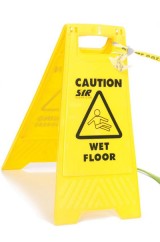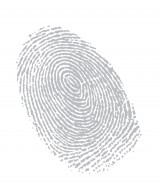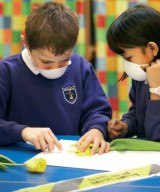Scalpel – or plastic knife – at the ready, Jonathan Lear sets out to investigate the mystery of a bed of tulips cut down in their prime...
Scalpel – or plastic knife – at the ready, Jonathan Lear sets out to investigate the mystery of a bed of tulips cut down in their prime…
One of the difficulties with our current curriculum is that there is little space for children to develop their creative thinking. The opportunities for them to generate questions, explore possibilities, or find imaginative solutions to problems can be limited. This topic starter aims to address this issue by allowing the children to explore the lighter side of crime and justice without any of the boring bits!
As dramatic starts go, this one takes some beating. It does however require a little behind the scenes preparation.
 The first step is to collect together the required materials to make a crime scene. For the sake of my explanation, the victims are going to be tulips (we’ll look at some alternatives later). As always when attempting to arrange something out of the ordinary, the first port of call is the caretaker’s cupboard. In most schools this is an Aladdin’s cave of marvellous bits and bobs. The raid, however, should only ever be done with the blessing of the caretaker – to try it without permission would mean almost certain death. The items needed are: a roll of tape (the kind used to cordon off an area), and four of those folding wet floor signs or similar sized cones. In addition to this you will need 15 tulips (or one between two for your class), chalk, small pieces of card numbered 1 to 15, 15 pairs of forceps (not essential, but very useful), a range of different magnifying glasses (microscopes would be amazing if you have them) and a pack of those plastic knives you get for parties.
The first step is to collect together the required materials to make a crime scene. For the sake of my explanation, the victims are going to be tulips (we’ll look at some alternatives later). As always when attempting to arrange something out of the ordinary, the first port of call is the caretaker’s cupboard. In most schools this is an Aladdin’s cave of marvellous bits and bobs. The raid, however, should only ever be done with the blessing of the caretaker – to try it without permission would mean almost certain death. The items needed are: a roll of tape (the kind used to cordon off an area), and four of those folding wet floor signs or similar sized cones. In addition to this you will need 15 tulips (or one between two for your class), chalk, small pieces of card numbered 1 to 15, 15 pairs of forceps (not essential, but very useful), a range of different magnifying glasses (microscopes would be amazing if you have them) and a pack of those plastic knives you get for parties.
Having procured the necessary items, all that remains is to find a space in which to begin creating the scene. The crime scene needs to be in a place that will not be seen by your children until the right time. My preference is inside school, although I’ve used the playground before on a dry, still day. The idea is to have a large square areacordoned off by the tape (the tape is held in place by one of the cones or signs at each corner). To add to the look, you could also attach ‘CRIME SCENE’ labels, or warnings about not tampering with evidence, around the outside of the scene.
Inside the scene, lay the tulip victims out haphazardly on the floor. If the floor permits, draw a chalk line around each victim and complete the scene by resting a numbered piece of card next to each one of them.
The final piece of preparation is a letter, the contents of which must include details about the terrible crime that has been committed and a request for help. If you avoid naming the victims in the letter, you get the added effect of being able to dramatically produce a dead tulip from an evidence bag.
 With everything in place, we’re ready to go. For added drama I like to have the letter delivered to class. It works really well if you start some other work with the children and then act surprised when interrupted with ‘urgent’ news. As a frustrated performer, the opening of the letter is my favourite bit – it allows me to demonstrate my finely honed ability to show a range of emotions – shock (wide open mouth), distress (wailing loudly) and outrage (loud voice and angry eyebrows). With the crime out in the open, re-read the sentence about needing help to find the perpetrator – all hands will shoot up.
With everything in place, we’re ready to go. For added drama I like to have the letter delivered to class. It works really well if you start some other work with the children and then act surprised when interrupted with ‘urgent’ news. As a frustrated performer, the opening of the letter is my favourite bit – it allows me to demonstrate my finely honed ability to show a range of emotions – shock (wide open mouth), distress (wailing loudly) and outrage (loud voice and angry eyebrows). With the crime out in the open, re-read the sentence about needing help to find the perpetrator – all hands will shoot up.
Have the children take a crime scene investigator oath during which you can sneak in some reminders about how they need to behave when out of classroom. When they’re ready, take them to the crime scene. On arrival, continue your cycle of extreme emotions until the children have taken in the terrible scene. Speak to them about how it is they are going to help. Explain that the first step will be to take the victims away and investigate a little further.
Send pairs into the scene to collect one of the tulip victims and then return to the crime lab (classroom). The next stage is dependent on the direction you wish to take the topic. The reason I chose tulips was to enable the children to explore the parts of a flower. They would use their forceps, scalpel (plastic knife!) and magnifying glasses to carry out an autopsy, recording their observations as they went. If this isn’t something you cover in your year group, there are plenty of other potential victims (see ‘Easy targets’).
Regardless of victim, the observational skills the children use will be the same. The aim of the session is to allow the children to record and then share, in any form they wish, the evidence or information that they’ve collected.
Any of the ‘Easy targets’ items would work well across a range of years, you would have to judge whether the crime scene is suitable for the particular age group, the children have to ‘get it’ – you don’t want younger children going home upset and telling parents something terrible has happened!
 Depending on what you want to teach, any of the following might be victims at your crime scene…
Depending on what you want to teach, any of the following might be victims at your crime scene…
1. Rocks/stones
Can the victims be identified? (Properties of rocks and soils)
2. Liquorice allsorts
Can the dismembered sweets be named? (Classification)
3. Different fruits/vegetables
Who could be behind the murder of these healthy foods? (A different take on healthy/unhealthy foods – good guys v bad guys)
4. Clothing – socks, gloves, hats
Can you describe the victims? (Exploring different materials)
 Taking the investigation further…
Taking the investigation further…
Having dealt with the immediate aftermath of the crime scene, regardless of which victims you choose, there are many different directions to explore.
In groups, the children work together to make sense of evidence left by the criminals. Set up five (one per group) areas in different places around school. In each area plant a range of different items that can be used to build a profile of the suspect. The objects can be completely random as you are aiming to give the children space to generate their own ideas and make their own connections. When they have collected the clues, they can discuss what information this might give them and build their own suspect. The children can then be encouraged to take this further, for instance:
• Having created a suspect, how would they go about apprehending them?
• Children could create wanted posters, film television appeals, write news or police reports.
• If the suspect was caught, they could script and role-play the interview – why did they commit such a terrible crime? (If you’ve gone down the healthy/unhealthy food route, the children could create animations using hamburgers as the villains).
• If charged, the suspects would be taken to court. Somebody would need to act for the defence as well as the prosecution. There’d have to be a judge and jury too, after all, the murder of innocent tulips is not to be taken lightly.
With their imagination fired, this topic will take on a momentum of its own. The direction the children take is anyone’s guess. The learning that they will experience along the way however, will be impossible to miss.
Kindness is contagious - give your colleagues a boost by recognising their efforts
Ace-Classroom-Support
How children react to a moral dilemma may be down to your teaching
Ace-Classroom-Support
Pie Corbett’s bike poems
Topic
Behaviour management: choosing the right words
Behaviour Management
